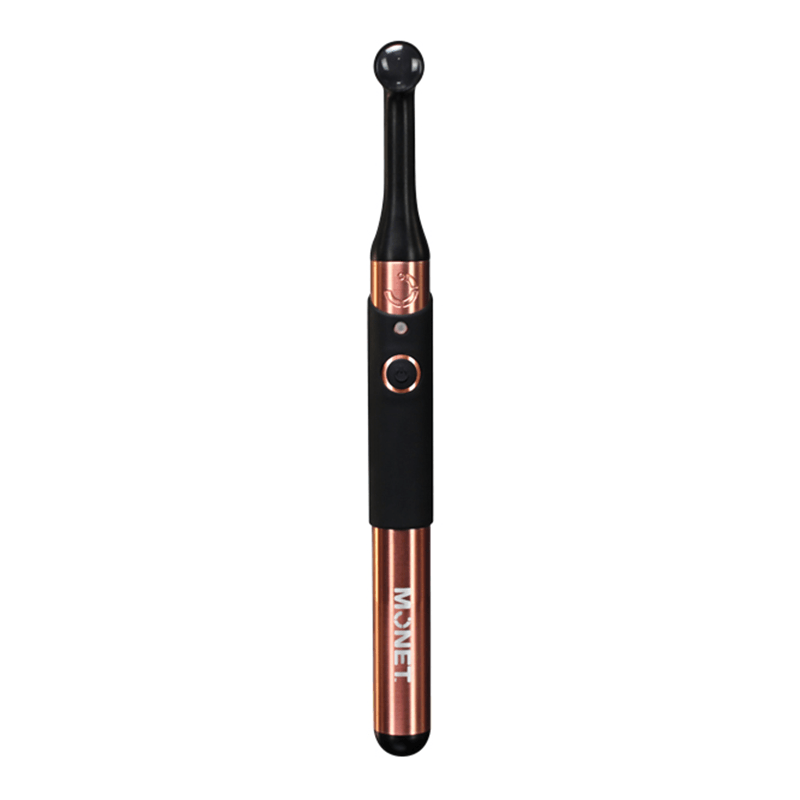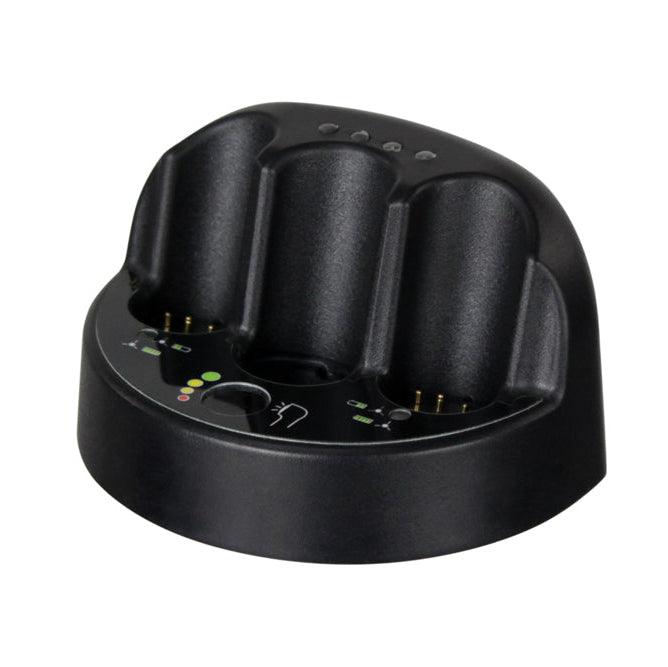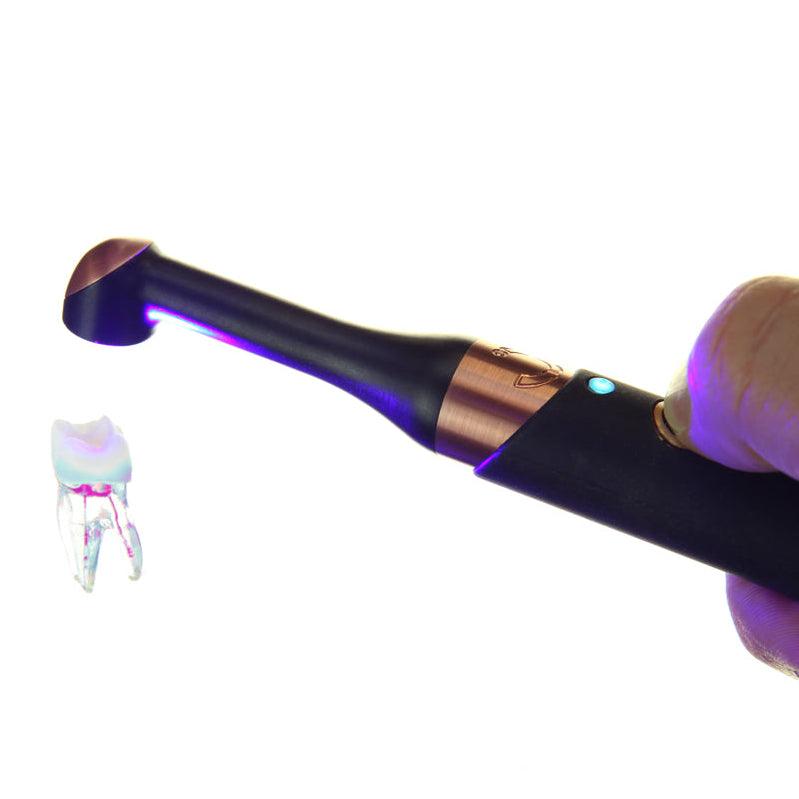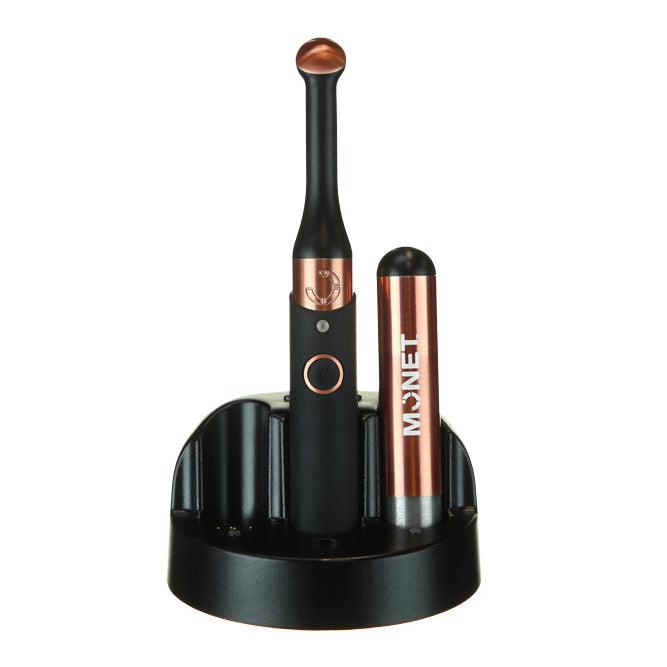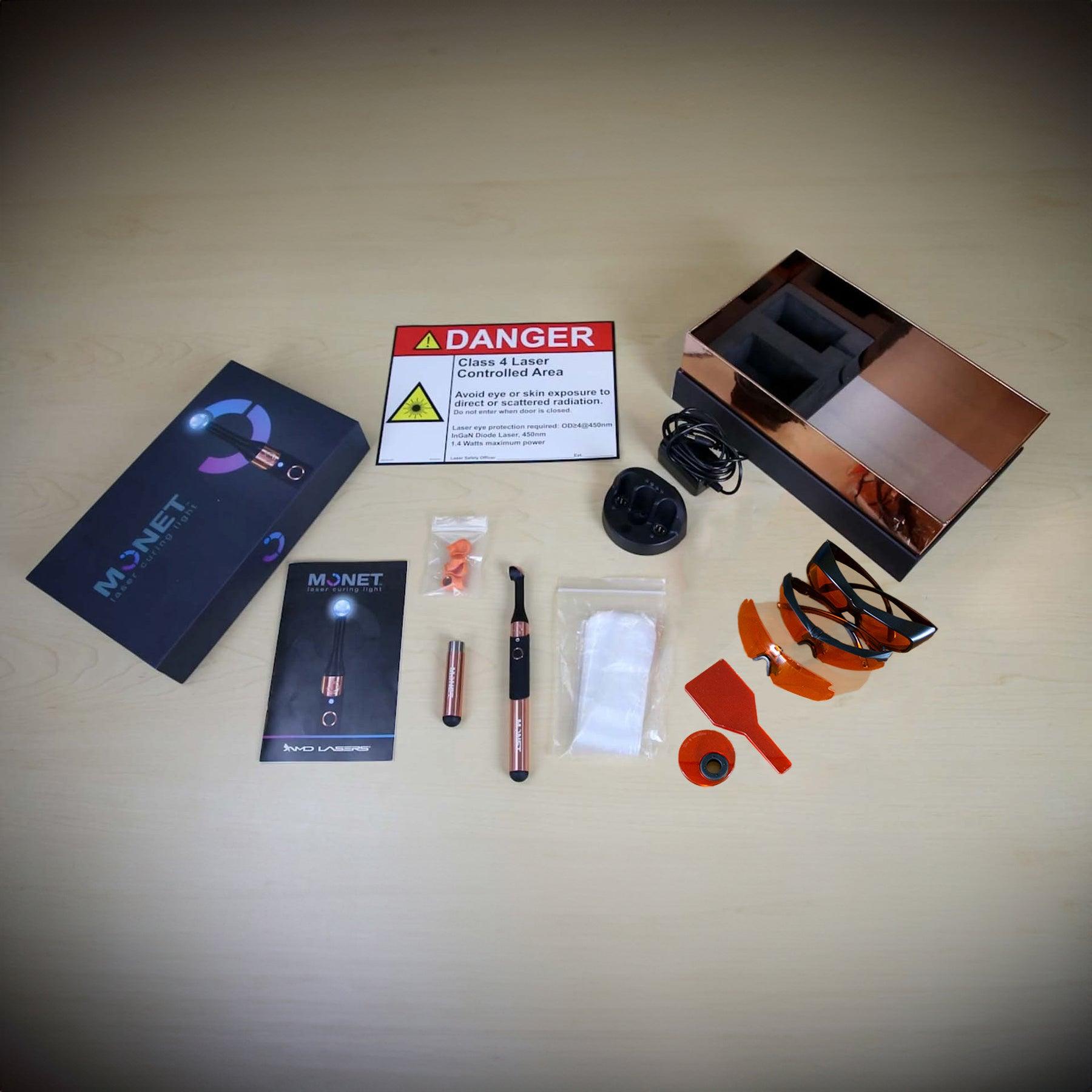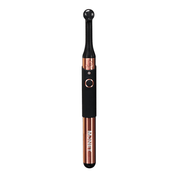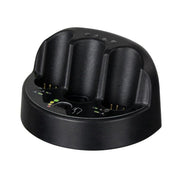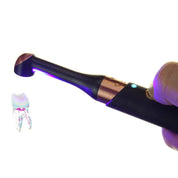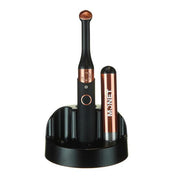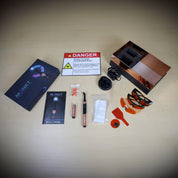Get Monet for Only $1,395 - Use Code MONET1395 at checkout
Monet Laser Curing Light
SKU: 001-00105
Get Monet for Only $1,395 - Use Code MONET1395 at checkout

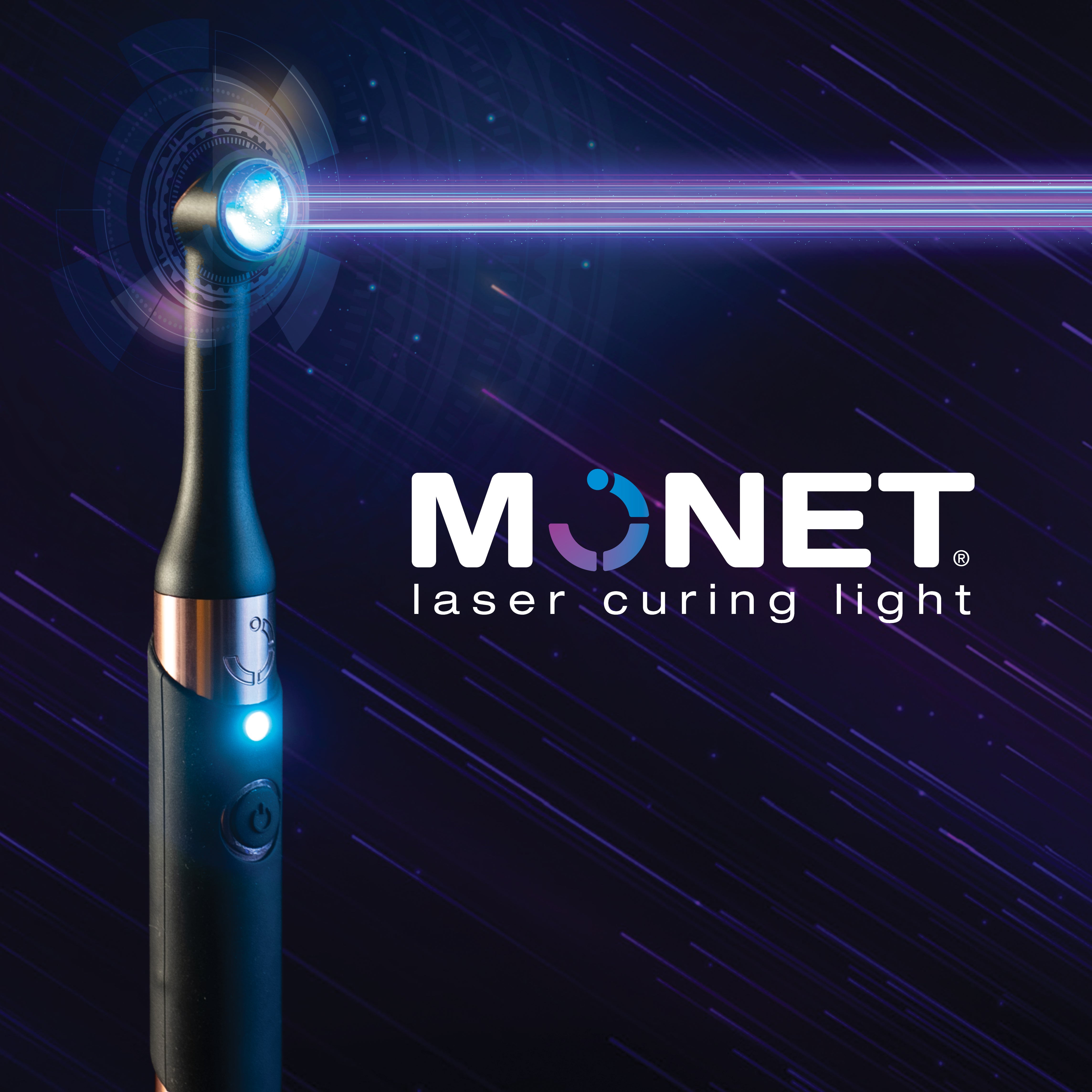
Monet Laser Curing Light:
Revolutionize Dentistry with Confident Curing
Embrace the Monet Revolution—Unleash the power of laser curing technology with the Monet Laser Curing Light and transform your composite placement procedures. Our revolutionary curing light delivers unprecedented curing speed, depth, and consistency, setting a new standard for efficiency, reliability, and research-backed performance in your practice. Don't just cure composites, revolutionize them!
Schedule a Monet demo today and discover how it can elevate your practice and transform patient care.
Features:
- Each click is a 1-second cure up to 2.5mm
- 8mm curing depth capacity
- Cures composites, luting cements, adhesives, and sealants
- Reduces shrinkage and debonding
- Reduces potential for “soft bottoms”
- Consistent dispersion for a deep cure
- Bulk fills in 3 Seconds
Included with Purchase:
- Compact laser module in a handheld form-factor
- Optics for parallel beam within the form-factor
- Unrestricted rotatable head mechanism
- Convenient battery attachment mechanism
- * 2-Year Warranty

The Monet laser curing light has been awarded the
Dentistry Today Top 50 Technology Products Readers' Choice Award 2023.

Your Patients are Ready for Lightspeed!
Patients are ready for improved care through the latest in dental technology. They are actively searching for practices with up-to-date and innovative patient care experiences.
Nothing disrupts a practice like an incomplete cure. Soft cures can leave patients with pain and prolonged sensitivity. A weak bond can even create future structural damage. With proper applications of the Monet, incomplete cures are now a problem of the past.


Laser Curing Means Confidence
Laser curing has major advantages over LED curing. With the Monet laser cure, you will never have to worry about incomplete bonds or soft cures. The Monet laser produces a deeper cure than LED or any other light sources during the same exposure time.
LED technology was a significant advancement, but LED curing lights present their own set of challenges.
- LED lights create a light pattern that can be dispersed away from the curing target when the energy from the LED light waves disperse.
- LED is a dispersed light source emitting at random times and random directions.
- LED needs a complicated optical system to collimate and homogenize the light beam.

Clinicians Report® was impressed with the Monet more than any other curing light, that they said:
"High irradiance output produced faster and deeper polymerization than other light sources"
See the reportLaser Curing Means Consistency
Laser curing provides a consistent dispersion of energy and intensity at any distance to create a complete, reliable, and even cure. The collimated beam creates a complete polymerization through composites.
The Monet’s laser diode beam emits from a controlled spot of the chip to generate a point light source, while an LED light emits from all surfaces and directions of the chip. With the 1-second curing speed and beam consistency you can now tackle bulk fills with just an extra second or two. Each click is a 1-second cure of 2.5mm, which means that bulk cures can be done in just 3 seconds.
Depth of Cure
Laser Curing is as simple as 1, 2, 3. With the Monet, it is generally recommended to do a single 1-second cure with a composite layer less than 2.5mm, two 1-second cures for composite layers between 2.5-5 mm, and three 1-second cures for layers more than 5 mm.
To control heat, do not cure any spot for more than 3 seconds in rapid succession. For prep areas larger than 8mm in diameter, two overlapping spot cures are recommended. Monet comes with 4 unique apertures for precision control of your laser. For preps near gingival tissues, please use one of the reducing apertures of 2, 4, or 6mm size to avoid light on gingival tissue. The Monet also comes with a reducing aperture which cuts the power by 50% to give you even more custom control!
Say goodbye to LED and Join the 1-Second Curing Revolution

Design
- Lens:
Directs the true collimated laser light. - Rotating Head:
Allows access to all intraoral areas. - Status Light:
Indicates the status of the unit. - Power Button:
Used to activate the high-intensity laser light for 1 second. - Battery Pack:
Can be detached and placed in the charging stand to recharge. - Charging Station:
Has 2 charging bays for Monet battery packs and is a stand for the Monet device.
Translating the Science: Monet Laser Curing Light

DENTAL ADVISOR® recently had the opportunity to test the Monet Laser Curing Light in their Biomaterials Lab, revealing some exciting insights!
The most common photoinitiator in composites is camphorquinone (CQ), which reacts to light wavelengths within a range of 430 – 510 nm, with absorption peaking around 468 nm. The closer a curing light’s spectral radiance is to the peak of 468 nm, the more effectively it cures. When the spectral radiant power of Monet Laser Curing Light was measured against competitors, the peak of the Monet Curing Laser was extremely close to the peak of CQ, activating CQ more effectively. This allows you to achieve full polymerization with better bonding and less shrinkage of bulk-filled composites in as little as three one-second exposures!
See the reportThe curing revolution began with the halogen curing light. When halogen curing was introduced in the early 1980s, it took 40 seconds to cure. These bulky curing lights were not very ergonomic, and engineers worked to address this issue by developing more efficient technology. The LED curing technology most dentists currently use was invented by our CEO, Densen Cao in 1999. With the LED light, dentists experienced a significant decrease in the amount of time that it took to cure. But LED lights have their own set of limitations. An innovative solution was needed to address ongoing problems of debonding and soft cures that hamper the effectiveness of curing. With that, the collimated light beam of the diode laser was born. A more efficient curing light with a collimated beam is revolutionary, but it needs to be practical. Densen Cao and our team of engineers took the curing light and enhanced it into the Monet Curing Laser.
Is This “Hype”?
A 1-second cure, you say? That’s too fast! Is it just “marketing hype”? If you think this is an exaggeration, you’re like other experienced and competent dentists that were initially skeptical. Here are some independent studies done to test the Monet and establish the accuracy of our claims.
Reality Now tested the Monet’s claims to determine the depth of composite cured for each second. This chart shows the results of those tests:
| Light | Curing Time (sec) | Height of cured composite (mm) | Depth of cure (mm) |
|---|---|---|---|
| Monet | 1 | 3.95 | 1.98 |
| Monet | 2 | 4.99 | 2.50 |
| Monet | 3 | 5.49 | 2.75 |
| Celalux 3 | 10 | 5.68 | 2.84 |
The Monet was tested in a separate independent study, by Dr. Mateus Rocha, Dr. Richard Price, and Dr. Christiane Maucoski published in the Journal of Dentistry 122 (2022() 04141. The study shows that the Monet laser cure is comparable to a standard LED light when the Monet cures at 1-second versus a 10-second cure with a standard LED light. It also shows the Monet at 3 seconds is comparable to 20 seconds with an LED curing light.
In a 1-second to 1-second curing comparison there's no contest; the Monet is faster than any other curing light on the market. The data shows that The Monet 1-second cure can achieve similar results for a 10 second cure by LEDs, and a 3 second cure by Monet yields similar results for a 20-second cure by LEDs.

Quick Curing Without Heat Concerns:
This study shows that curing composite fillings in just 1-3 seconds with the Monet Laser Curing light (even though it's powerful) doesn't cause the pulp to overheat. Why? The total energy delivered, in such a short time, doesn't heat the pulp chamber enough to put the pulp tissue at risk.
See the Research Article on In-vitro pulpal temperatureLaser Curing is Safe
Lasers have been used in dentistry for years, including soft-tissue and larger laser curing devices. While some dentists are concerned with the heat intensity when using a laser to cure composite, all research shows lasers are completely safe.
Tissue damage can occur when pulp tissue temperature increases by 5.5° C. When tested by Clinicians Report at five seconds (two seconds beyond usage recommendations), the Monet stayed within safe heat parameters. The Monet is a laser curing light, and with all lasers and curing lights proper safety eyewear must be worn. For the safety of you and your patients, the Monet comes with two sets of laser safety goggles, a laser-safe loupe insert, and a paddle.
Patient safety is paramount. The Monet Laser Curing Light prioritizes safety features and requires proper training for dentists. AMD Lasers offers comprehensive training programs to ensure the safe and effective use of the laser in your practice.

“The laser curing light on 3M composite showed less debonding in both 8mm and 1mm distances, compared to LED curing light.”
Download the PDFSay goodbye to LED and join the curing revolution!
It's not rocket science. When 60-80% of the procedures in your office involve composite curing, by eliminating soft cures and cutting chair time, the patient experience improves, and your practice can see more patients and build more revenue. Say goodbye to LED and join the 1-second curing revolution.
Revolutionary Practices
Learn about how other dentists have effectively integrated the Monet Laser Curing Light into their practices. Dr. Mike Ditolla sits down with dental professionals who have joined the 1-Second Curing Revolution.


Learn More
"The use of a handheld curing laser greatly shortens the curing cycle and therefore allows the dental clinician and team to operate at peak efficiency while also achieving superior clinical results. By minimizing the time spent curing adhesive materials, the clinician can accomplish adhesive procedures in less time, with less stress, and be assured that the final restorations will achieve high-quality esthetics and optimal longevity."
- Dr. John Flucke
Download Dr. John Flucke’s FREE CE ebook: Handheld Curing Lasers and Other Modalities to Increase the Clinical Efficiency of Bonding Procedures and learn how the Monet Laser Curing light can improve the efficiencies in your practice.
Download the PDF
Still not sure if you are the revolutionary type?
Revolution is said to be a struggle of the past against the future. It’s time to start embracing progress. Think it sounds too good to be true? It’s time to see it for yourself!
Schedule a virtual demo with one of our experts and get a first-hand look at this amazing technology.

- Faster Curing: Experience a paradigm shift in curing times. Monet's laser technology cures composites in 1-second intervals. Based on the composite and restoration, complete polymerization is achieved in 1 to 5 intervals, significantly reducing chair time.
- Unmatched Curing Confidence: The collumated Laser beam and no loss of energy at a distance allows the Monet to achieve consistent and reliable cures throughout the entire composite restoration, regardless of depth, minimizing the risk of postoperative sensitivity.
- Research-Backed Performance: Monet's curing efficacy is supported by extensive clinical studies and research, ensuring predictable and reliable results for your patients.
- Improved Patient Comfort: Minimize patient discomfort and anxiety associated with prolonged curing times.
- Reduced Risk of Errors: Eliminate the human error associated with traditional light positioning and ensure consistent, complete cures every time.
- Minimized Post-Operative Sensitivity: Achieve deeper and more complete cures. While the speed will leave patients impressed, reducing the risk of post-operative sensitivity will improve patient satisfaction.
- Investing in the Future of Dentistry: The Monet Laser Curing Light represents a forward-thinking investment in your practice.
- Elevate Your Practice Standards: Showcase your commitment to cutting-edge technology and provide exceptional care to your patients.
- Streamlined Workflows: Experience faster curing times and improved workflow efficiency for a more productive practice.
Need instructions to use your Monet Laser Curing Light?
Download Monet User Manual - Mar. 2025

